Recently I was interviewed by Meg Proctor from the Two Sides of the Spectrum Podcast. We talked about lots of different topics around Comprehensive Literacy Instruction including making sure each student has the easiest and most appropriate writing tool. As part of this I mentioned sensory pencils – and a couple of people have messaged me for more information. So – a new blog post is born!
A little further down in this blog post, is a video. The toddler in the video is at the stage sometimes called “driting” (Hall & Williams, 2003). They scribble – and adults around them make comments about their wonderful marks, and attribute meaning to them – and those same adults move between calling their scribbling “writing” and “drawing”, depending on the context. At this stage, there is no difference between the marks they make that we call writing and the marks we call drawing.
Over time, the child will start attributing their own meaning. The child will also move between calling it drawing or writing, depending on the context. Once again, there is no difference between what they are calling writing and what they are calling drawing – hence the term “driting”.
And now, before this blog post goes any further, I would like you to watch the video.
Having watched the video, I want you to consider which aspects of the scribbling really engaged the child.
Was it:
- Banging the writing tools?
- The texture of the tools?
- The texture of the paper?
- Adult interaction?
- Production of marks?
- Other parts?
Whenever I watch toddlers scribbling I realise how many of the sensory aspects of scribbling are the factors that drive engagement at this early stage. Their engagement then helps them to learn from each experience, gives them reasons to continue scribbling, and contributes to their journey in learning that they are a writer.
Watching toddlers scribble has also made me think about how we replicate these experiences for the early emergent writers that we work with.
If you look at my blog post Tools for Writing: A Suggestion and Selection Guide you will see a range of writing tools that I suggested (in 2019) that we might make available for emergent writers to use. I continue to use these tools – however, as I have thought more about early emergent writing, I realised that these tools don’t necessarily have the sensory aspects that some students would benefit from as we aim for a level of engagement similar to the toddler in the video.
There are a couple of writing tools that I mentioned in that blog post that do have some extra sensory aspects, and at the time of publishing that Tools for Writing blog post I had noticed how much more engaged some students were with those tools. This engagement then helped them to learn more about writing and being a writer.
These tools are:
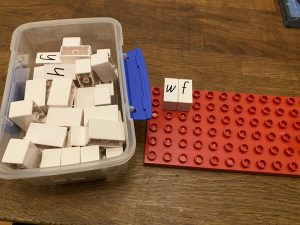
Coko Lower Case Educational Bricks, which have been a real hit with some students. Being able to bang them, stack them, and scribble with them has built engagement and allowed us to play while writing.
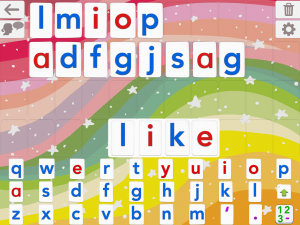
The app called Word Wizard which has also been very successful with some students. It has a tool called a “talking moveable alphabet” which has been awesome – it enables a student to drag letters, have the letters talk and then listen to the sound of the “words” they have written.
Putting together my observations of toddlers scribbling, and the success I had with some students with these two writing tools that contain some sensory components, I decided that it might be helpful to try some other writing tools with some of the early emergent students I was working with. These students had been writing with flip charts for over a year, but hadn’t really engaged with writing. Since they weren’t engaged, it made it very hard for us to have the successful interactions with them that we needed to have. So, I decided that we needed some new options to try as writing tools. These options needed to offer access to all 26 letters of the alphabet, and provide some sensory aspects that engaged students so that we could support them in their journey of learning to be a writer.
And so, I started thinking more laterally and pulled together a bunch of what I started to call “sensory pencils.” Most of these were made up of resources I already had in my toolkit for alphabet activities.
Here are some of my early options:
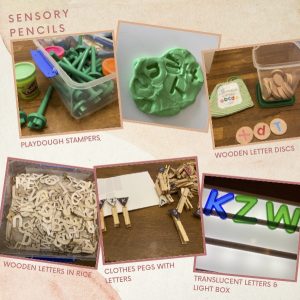
As I took these sensory pencils into classrooms, I was able to trial these with different early emergent writers. Students often naturally gravitated to one of the tools, spending considerable time engaging with it and offering classroom staff opportunities to write down letters that they were more interested in, then make comments about their wonderful writing, and attribute meaning to it. It was fabulous to see this happening with students who hadn’t previously engaged with writing activities.
Some of the amazing teachers I work with developed specific sensory pencils for their students. Here’s a selection made up by Karen from Errington Special Education Centre.

Over time we’ve seen these sensory pencils making a big difference with some early emergent writers. We have seen students who didn’t engage in writing with flip charts, becoming much more engaged with writing and learning that they are a writer, that print has meaning and that text is a code for speech. Once they have learned this, many of these same students began to choose to use flip charts and write with them. (And, of course, some students have engaged with flip charts from the very beginning as well!)
We’ve also learned that it’s very important that students transition away from using a sensory pencil like the ones that Karen and myself made! It is very difficult for students to learn to deliberately select a letter of the alphabet or to create a “space” between letters in an organised way when the letters are all in a jumble! So – we are only using sensory pencils with early emergent students.
Bullimbal School loved the concept of sensory pencils so much that they made up amazing sensory pencil kits for every classroom.
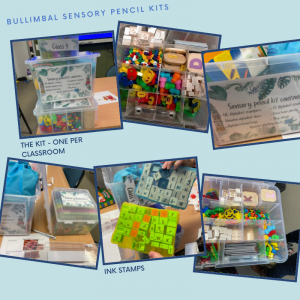
Bullimbal introduced these kits last year to use with early emergent writers who hadn’t engaged in writing with flip charts. In 2021 they had 11 students in the school who were identified as using sensory pencils. In 2022 they only have 3 students in the school using sensory pencils – the majority of students who used them last year are now using flip charts as their main writing tool.
And so, I hope this blog post explains about sensory pencils, why we are using them and the students we use them with. And helps you to figure out some writing tool options to engage any early emergent writers that you are working with!

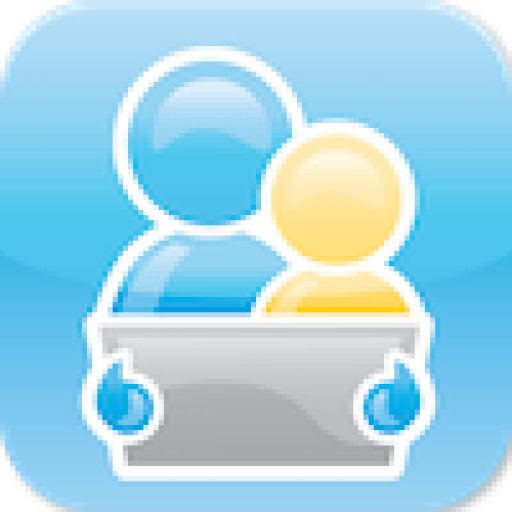
Jen
jane
Kait
jane
Kait